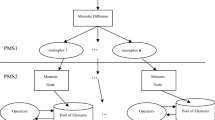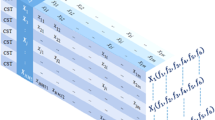Abstract
It had been proved that the knowledge may promote more efficient evolution. Considering the knowledge defined in different form, we present interval multi-objective quantum-inspired cultural algorithms so as to effectively utilize the implicit information embodied in the evolution to promote more efficient search. It adopts the dual structure derived from cultural algorithm. In population space, the rectangle’s height of each allele in real-encoding quantum individuals is calculated in terms of the possibility dominant rank, instead of the relative fitness values. Three kinds of crowding operators are defined, including the crowding distance of hypercube, the harmonic distance of hypercube and the coverage rate of hypercube to grids, to measure the crowding degree among evolutionary individuals. In belief space, the knowledge is used to guide selection and mutation operations of evolutionary individuals and the update operation of quantum individuals. The statistic simulation results for four benchmark functions indicate that the solutions obtained from the proposed algorithms more close to the true Pareto front uniformly and the uncertainty of non-dominant solutions is less. Furthermore, the knowledge extracted from the evolution plays a positive role in improving the convergence and distribution.










Similar content being viewed by others
Explore related subjects
Discover the latest articles and news from researchers in related subjects, suggested using machine learning.References
Wang G, Guo L, Wang H, Duan H, Liu L, Li J (2014) Incorporating mutation scheme into krill herd algorithm for global numerical optimization. Neural Comput Appl 24(3–4):853–871
Nguyen TT, Yao X (2012) Continuous dynamic constrained optimisation—the challenges. IEEE Trans Evol Comput 16(6):769–786
Jin YC, Branke J (2005) Evolutionary optimization in uncertain environments—a survey. IEEE Trans Evol Comput 9(3):303–317
Cheng ZQ, Dai LK, Sun YX (2004) Feasibility analysis for optimization of uncertain systems with interval parameters. Acta Autom Sin 30(3):455–459
Sengupta A, Pal TK (2000) On comparing interval numbers. Eur J Oper Res 127(1):28–43
Allahdadi M, Mishmast Nehi H (2013) The optimal solution set of the interval linear programming problems. Optim Lett 7(8):1893–1911
Da QL, Liu XW (1999) Interval number linear programming and its satisfactory solution. Syst Eng Theory Pract 19(4):3–7
Inuiguchi M, Sakawa M (1995) Min-max regret solution to linear programming problems with an interval objective function. Eur J Oper Res 86(3):526–536
Zhang JJ, Fan YY (2003) The optimality conditions of interval number linear programming problem. Oper Res Manag Sci 12(2):44–47
Jiang C, Han X, Han G et al (2007) The optimization of the variable binder force in u-shaped forming with uncertain friction coefficient. J Mater Process Technol 182(3):262–267
Jiang Z, Dai LK, Wu TJ (2005) Deterministic interpretation of interval nonlinear programming and its hierarchical optimization solutions. Syst Eng Theory Pract 25(1):110–116
Liu ST (2006) Computational method for the profit bounds of inventory model with interval demand and unit cost. Appl Math Comput 183(1):499–507
Kao C (2006) Interval efficiency measures in data envelopment analysis with imprecise data. Eur J Oper Res 174(2):1087–1099
Zhang Y, Gong DW, Zhang QY et al (2009) Deterministic interpretation for uncertain optimization problems with interval constraints. Syst Eng Theory Pract 29(2):127–133
Zhang Y, Gong DW, Hao GS et al (2008) Particle swarm optimization for multi-objective systems with interval parameters. Acta Autom Sin 34(8):921–928
Zhang Y et al (2013) Robot path planning in uncertain environment using multi-objective particle swarm optimization. Neurocomputing 103:172–185
Zhou J et al (2014) Multi-objective optimization in uncertain random environments. Fuzzy Optim Decis Mak 13(4):397–413
Li FY, Li GY, Zheng G (2010) Uncertain multi-objective optimization method based on interval. Chin J Solid Mech 31(1):86–93
Eskandari H, Geiger CD, Bird R (2007) Handling uncertainty in evolutionary multi-objective optimization: SPGA. In: Proceedings of IEEE congress on evolutionary computation, New York, pp 4130–4137
Shi JR, Liu SY, Gao SP (2004) Chance-constrained approach for multi-objective linear programming with interval coefficients. Univ Shanghai Sci Technol 26(4):314–317
Limbourg P, Aponte D (2005) An optimization algorithm for imprecise multi-objective problem functions. In: Proceedings of IEEE congress on evolutionary computation, Edinburgh, pp 459–466
Gong DW, Qin NN, Sun XY (2010) Evolutionary algorithm for multi-objective optimization problems with interval parameters. In: Proceedings of fifth IEEE international conference on bio-inspired computing: theories and applications, Changsha, pp 411–420
Soares GL, Guimars FG, Maia CA, Vasconcelos JA, Jaulin L (2009) Interval robust multi-objective evolutionary algorithm. In: Proceedings of IEEE congress on evolutionary computation, Trondheim, pp 1637–1643
Guo Y, Yang Z, Wang C, Gong D (2015) Cultural particle swarm optimization algorithms for interval multi-objective problems. advances in swarm and computational intelligence. Lect Notes Comput Sci 9140:505–512
Wang G, Gandomi AH, Alavi AH, Deb S (2015) A hybrid method based on krill herd and quantum-behaved particle swarm optimization. Neural Comput Appl. doi:10.1007/s00521-015-1914-z
Najaran T, Akbarzadeh M (2009) Improvement of quantum evolutionary algorithm with functional sized population. Appl Soft Comput 46(2):389–398
Guo Y, Zhang P (2015) Multi-objective quantum-inspired cultural algorithm. In: 2015 2nd International conference on soft computing and machine intelligence, pp 25–29
Yang C, Feiqi D, Yang H (2009) Quantum-inspired evolutionary algorithm to solve multi-objective numerical optimization problems. J South China Univ Technol 37(1):79–85
Meshoul S, Mahdi K, Batouche M (2005) A quantum inspired evolutionary framework for multi-objective optimization. Lect Notes Artif Intell 3808:190–201
Kim Y, Kim J-H, Han K-H (2006) Quantum-inspired multi-objective evolutionary algorithm for multi-objective 0/1 knapsack problems. In: 2006 IEEE congress on evolutionary computation. Vancouver, pp 9151–9156
Xiawen Y, Yu S (2011) A real-coded quantum clone multi-objective evolutionary algorithm. In: Proceeding of international conference on consumer electronic, communications and networks, pp 4683–4687
Reynolds RG (1994) An introduction to cultural algorithms. In: Proceeding of the third annual conference on evolutionary programming, pp 131–139
Best C, Chen X, Reynolds RG, Liu D (2010) Multi-objective cultural algorithms. In: Proceeding of IEEE congress on evolutionary computation, pp 1–9
Cruz AVA, Vellasco MBR, Pacheco MAC (2006) Quantum-inspired evolutionary algorithm for numerical optimization. In: Proceeding of IEEE congress on evolutionary computation. Vancouver, pp 19–37
Wang G-G, Guo L, Gandomi AH, Hao GS, Wang H (2014) Chaotic krill herd algorithm. Inf Sci 274:17–34
Wang Z, Tang K, Yao X (2010) Multi-objective approach to optimal testing resource allocation in modular software systems. IEEE Trans Reliab 59(3):563–575
Wang G-G, Gandomi AH, Alavi AH (2014) Stud krill herd algorithm. Neurocomputing 128:363–370
Acknowledgments
This work was supported in part by National Natural Science Foundation of China under Grant 61573361, Research Program of Frontier Discipline of China University of Mining and Technology under Grant 2015XKQY19, Outstanding innovation team of China University of Mining and Technology under Grant 2015QN003 and National Basic Research Program of China under Grant 2014CB046300.
Author information
Authors and Affiliations
Corresponding author
Rights and permissions
About this article
Cite this article
Guo, Yn., Zhang, P., Cheng, J. et al. Interval multi-objective quantum-inspired cultural algorithms. Neural Comput & Applic 30, 709–722 (2018). https://doi.org/10.1007/s00521-016-2572-5
Received:
Accepted:
Published:
Issue Date:
DOI: https://doi.org/10.1007/s00521-016-2572-5




